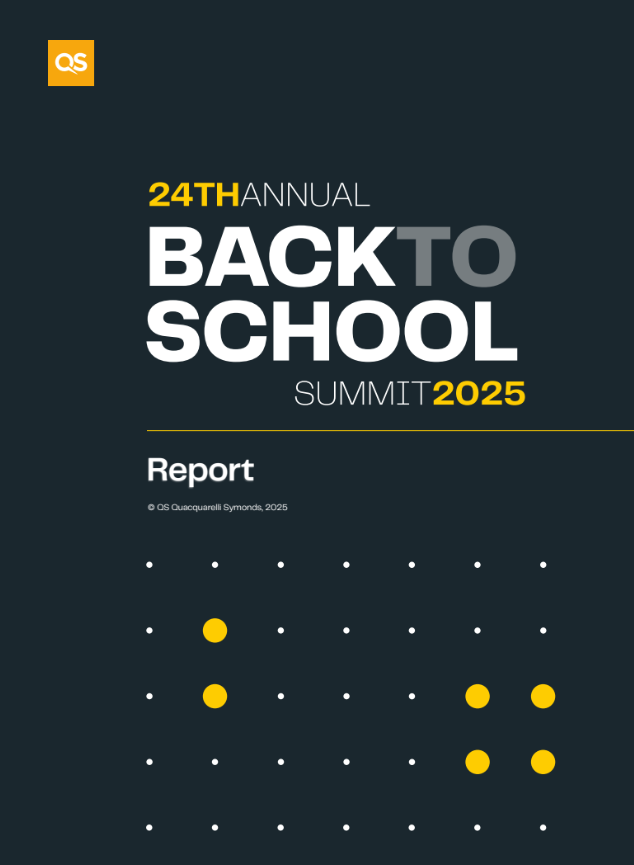This report summarises the key talking points from the 24th Back to School Summit, held in New York in September 2025. Including sessions from the AI, Tech & Finance, Higher Education & Skills, and Foundation tracks as well as roundtables and workshops, the report gives insights into the current concerns of leaders, educators, policymakers, entrepreneurs, and investors. Concerns include AI, access to higher ed, curriculum development, skills and lifelong learning, and funding.
Below is a short excerpt. Download the full report to learn more.
Executive summary
The Summit highlighted critical structural challenges in the education-to-employment pathway, the financial sustainability of higher education, and the strategic role of investment and policy in navigating this turbulent period. Recurring themes centered on the urgency of aligning learning outcomes with workforce needs, the need for new funding mechanisms for innovation, and the ethical implementation of AI to ensure equitable access and positive societal impact.
.jpg)
AI and the automation of entry-level jobs
A primary and immediate concern is the impact of AI on the workforce, specifically the automation or augmentation of entry-level white-collar jobs. Companies are increasingly automating menial tasks, leading to decreased entry-level hiring and rising job requirements, expecting new graduates to perform at a higher skill level sooner. This accelerates the expectation that a 21-year-old should perform at a 30-year-old level.
Employers must be encouraged to invest in early talent and entry-level positions, even if those tasks could be automated, to maintain talent pipelines. Educational models must adopt "Earn and Learn" strategies, such as apprenticeships and co-op programs, which do not require previous experience to enter the training pipeline.
The critical shortfall in durable skills
While technical skills are essential, employers consistently report that the biggest gap in entry-level talent is the lack of "durable skills" (also called human skills, soft skills, or enduring skills). These include critical thinking, collaboration, communication, and emotional intelligence - skills necessary for adaptability and using judgment. These skills are vital because they are uniquely human and necessary to manage and lead technology.
Durable skills training cannot be standalone but must be embedded through authentic projects, experiential learning, and intentional development. Institutions should document and measure these skills, particularly those gained during capstone courses and work-integrated learning, as they are the experiences closest to actual work.
Urgency of AI and digital Fluency across the curriculum
The job market is rapidly incorporating AI fluency expectations, with job descriptions on platforms showing a 300% increase in basic AI experience requirements. This urgency demands that both students and educators acquire foundational AI literacy, understanding what AI is, how it works, and its responsible and ethical applications.
AI literacy must be embedded across all academic subjects rather than being treated as a separate, specialised class. Educators require significant professional learning and development to upskill. Universities must position students as "creators" and not just consumers of AI, which requires access to high-end infrastructure and training.
Structural challenges and financial stress in higher education
Higher education is under severe fiscal pressure due to declining undergraduate enrollment, unsustainable levels of student and institutional debt, and increasing demands from students and government regulators for demonstrated Return on Investment (ROI). Institutions are often forced to innovate quickly but struggle due to internal inertia.
Institutions must adopt integrated strategies that blend online and on-campus offerings, and degrees with non-degree credentials. Leaders must embrace centralised approaches to marketing and operations, and use data-driven decision-making to validate program viability and strategically cut "stinker" programs, saving millions.
Inaccessibility of high-quality experiential learning
The traditional 10-week summer internship model is often inaccessible to the majority of students, especially those outside elite universities or those with family or financial constraints, leading to a profound "experience gap". Employers, meanwhile, have a limited mechanism for engaging widely with potential entry-level talent.
Innovative, scalable models like "sprint internships" (short, paid micro-internships for groups of students) can provide high-impact resume credentials. Policy can incentivise companies to become "teaching companies" through tax breaks or regulatory relief to host students. Work-based learning should be considered a requirement for graduation.
The inertia of traditional academic pedagogy
The current "factory system" of education, characterized by rigid curriculum structures and slow change management, fails to prepare students for ambiguous, real-world problems. Revising syllabi and launching new programs can take years due to faculty committees and bureaucratic processes, far slower than the pace of change in the labour market.
Faculty must be supported and incentivized to evolve curriculum and pedagogical practices. Education should focus on problem-based learning and project-based experience rather than rote memorisation or content delivery. Universities should question historical conventions like credit hours, which may no longer serve the modern learner.

Navigating the AI hype cycle and ethical implementation
A massive amount of capital is chasing AI adoption in education, often without evidence of efficacy or grounding in research. This "hype cycle" creates pressure for organisations to adopt AI without a clear problem to solve ("AI for what?"). Furthermore, there are serious concerns about model bias (e.g., failing to recognise diverse dialects), data privacy, and the risk of technology being used to marginalise vulnerable populations.
Philanthropy must lead by injecting "appropriate skepticism" and advocating for common values and guardrails. Investment should focus on developing open-source data sets and R&D infrastructure ("test beds") to ensure responsible and ethical technology design.
Deficiencies in data and measurement systems
Public sector data systems are often archaic, siloed, and disconnected, making it difficult for states and institutions to measure impact, ROI, or the effectiveness of new programs (like Workforce Pell). Critically, there is a lack of rigorous, scalable mechanisms to assess and certify durable skills and AI literacy.
Universities must adopt a transparent, data-driven culture and build unified data systems (e.g., a "know your student" data lake). A "skills transcript" or digital credential, possessing the same rigor and integrity as an academic transcript, should be developed to demonstrate job-ready competencies to employers.
The void in lifelong learning infrastructure
The current societal structure assumes that foundational education received in the first 20 years of life will suffice for a multi-decade career, a concept deemed "risible" given that 37% of job skills are replaced in five years. This lack of infrastructure leaves millions of Americans "stuck" in low-wage, high-churn jobs without a clear path to re-skilling or advancement.
The focus must shift from a "schooled society" to a "learning society". Strategies should target "frontier skills" and jobs that offer high demand and economic mobility, aligning the efforts of employers, educators, and policymakers. Clear "nutrition labels" for credentials are needed to ensure workers understand which training leads to real advancement.
Geopolitical shifts and the international education market
Global shifts in economics, geopolitics, and demographics are reshaping international student flows. While the US remains a top destination, its growth rate is slowing relative to competitors, and institutions are increasingly reliant on international student revenue, which is threatened by visa issues and political climate. By 2030, 42% of the world's youth will come from Africa, representing a massive demographic shift that traditional recruitment models are ill-equipped to handle.
Institutions must diversify recruitment beyond traditional markets (India, China) to include emerging regions like Africa and Latin America. Universities must strengthen their employer reputation and explicitly market employability outcomes to attract global talent.
Philanthropy’s struggle to deploy capital effectively
While there is significant wealth, many donors lack a clear strategy for investing in the complex AI/EdTech space, often leading to a focus on "hot" topics rather than core needs. Nonprofits focused on core educational missions struggle to compete for funding against AI-driven projects, and often lack the technical expertise needed to responsibly integrate technology.
Philanthropy should resist shifting its focus entirely to AI just because it is "hot". Funders can help by providing fractional technical support or "engineering hubs" rather than just cash, allowing nonprofits to strategically determine their technical needs and prevent inefficient spending. Philanthropy should also support collaboration and cohesion among multiple partners aimed at systemic, scalable goals.
The need for deep collaboration and anchor assets
Systemic change is too complex for single institutions or organisations; deep collaboration between academia, industry, government, and philanthropy is essential but historically difficult. Institutions often try to sound the same, spending millions on marketing rather than leveraging their unique strengths.
Consortiums, such as the Empire AI initiative, can pull together public, private, and philanthropic resources to invest in massive shared infrastructure (like supercomputing centers) that no single university could afford, thereby accelerating research and workforce training. Universities must identify and leverage their "anchor assets" - unique, non-copyable differentiators (like location or specialised facilities) - to drive mobility and recruitment.
Protecting student well-being in a tech-driven world
The rise of ubiquitous technology, particularly social media and AI companions, correlates with rising youth anxiety and mental health issues. There is a concern that individualised AI learning risks fracturing social connection, which is a key purpose of education.
Technology adoption requires strong guardrails, transparency, and a high "duty of care". Schools must be intentional about fostering social learning and civic community, ensuring technology serves as a tool rather than replacing human interaction and mentorship. Policy must address the issue of big tech having inadequate self-monitoring, establishing an "intermediary" role for EdTech to protect student privacy and ensure safety.
Education in the decade ahead growth drivers, risks & opportunities
Day 1, Grand Hall
Maria Spies, Co-Founder at HolonIQ & Chief Innovation Officer at QS
Patrick Brothers, Co-Founder at HolonIQ & Executive Director at QS
The 24th annual Back to School Summit, led by QS, emphasized the importance of transforming global education and skills. Key discussions included the impact of ed tech funding, with K-12 learner and teacher support attracting the most private funding. China was highlighted as the country with the fastest-growing research focus. The expected peak year for U.S. high school graduates is 2025, with 8.5 million international students expected globally by 2030. The summit also covered the significance of AI, with universities valuing willingness to experiment as the most important factor for successful AI projects.

Global shifts and industry 4.0
Maria Spies introduced the opening presentation, which will cover macro factors shaping the world, global shifts, and the future of learning and work. Patrick Brothers begins by discussing global shifts, including power shifts, economic shifts, resource and energy shifts, demographic shifts, and urban shifts. He emphasized the impact of these shifts on education, work, and learners, highlighting the importance of understanding these changes.
Economic and resource shifts
Maria Spies elaborated on economic shifts, noting the growth of economies like India and China and the unsustainable levels of debt in many countries. She discussed the employment landscape, including mass layoffs and talent shortages, and the impact of trade relationships on prices and jobs. Patrick Brothers added that resource shifts, such as the boom in technology and electrification, drove a move back to critical minerals and secure energy sources.
Demographic and urban shifts
Maria Spies highlighted the demographic shifts, noting the expected population growth and the aging population, which impacted lifelong learning and support for older populations. She mentioned that by 2050, almost 70% of the world's population would live in urban environments, posing significant challenges for social infrastructure. Patrick Brothers discussed the impact of technology, including artificial intelligence, virtual reality, augmented reality, and robotics, on learning and work.
Behavioral shifts and future skills
Maria Spies addressed behavioral shifts, such as the loss of institutional trust, the rise of disinformation, and the impact of social media on mental health. She emphasised the importance of education institutions in helping learners navigate these challenges. Patrick Brothers introduced the concept of future skills, breaking it down into six thematics and 12 industries, and mapping 50,000 skills across different occupations.
Impact of AI on automation and augmentation
Patrick Brothers discussed the impact of AI on automation and augmentation, highlighting the need for institutions and governments to prepare learners for the future of work. He explained how AI could be both a threat and an opportunity, depending on the occupation and the level of automation exposure. The discussion emphasised the importance of understanding these shifts to support learners and workers in the evolving job market. Maria Spies highlighted that Africa would be home to 40% of the world's children by 2030, emphasising the need for innovative education solutions. She also noted that online enrolments in the US were growing, with 5 million online enrolments in colleges and universities despite a decline in overall enrolments. AI increasingly influenced how young people searched for information, made educational choices, and planned their careers. By 2030, short non-degree credentials were expected to be the most awarded credentials in the US, with universities adapting to this trend.
Performance of systems and institutions: USA and global perspectives
Patrick Brothers reviewed 150 years of K–12, high school graduates, and higher education enrolments in the US, noting declines and shifts in participation. He observed that the rise of Chinese and Indian institutions in global university rankings was significant, with China investing heavily in research and employability. Academic reputation deteriorated in the US and UK while rising in China and India, highlighting the importance of research and employability. He also underscored that employer reputation was crucial for institutional success, with some countries improving their standing while others lagged behind.
Innovation and technology in education
Maria Spies discussed the importance of innovation and technology in education, noting that $4.5 billion had been invested into education technology companies over the last few years. Venture capital investment supported teachers, students, and career support, although there had been a decline in investment since 2020. Around $500 billion had been allocated globally for reskilling and upskilling, with a significant portion directed toward AI and technology-related training. Newly formed EdTech companies focused on upskilling workforces and K–12 education, leveraging AI for various educational needs.
AI and institutional success
Maria Spies explained that successful AI projects in universities required a willingness to explore and experiment, with clear leadership and vision as key factors. She described how the QS AI Capability Framework helped institutions structure and categorise their AI projects across various stages, from governance to operational efficiency. AI was used in teaching, learning, assessment, research, and scholarship, with the framework aiding in tracking progress and mapping current activities. Patrick Brothers highlighted the importance of data, benchmarking, and generating insights to support institutional missions and innovation.
Future of education and technology
Patrick Brothers introduced the 100 billion-plus data point Knowledge Graph, which connected skills with institutional performance, student recruitment, and innovation. The graph leveraged AI to validate, refine, and build datasets, supporting the missions of QS and HolonIQ. The goal was to unleash the potential of learners and provide information and insights for decision-making in education, institutions, governments, employers, and investors. Maria Spies concluded the keynote by encouraging participants to stay for the opening power panel and connect with their neighbours to share new ideas and insights.
Beyond first degrees building lifelong learning ecosystems & AI-ready talent strategies
Day 2, Grand Hall
Matt Sigelman, President at The Burning Glass Institute
The discussion emphasised the urgency of lifelong learning in the era of AI, highlighting that 37 million Americans are stuck in low-wage jobs, and 37 million have incomplete college degrees. AI is changing job skills, with a 16% decline in demand for AI-overlapping skills and an 8% increase in augmented skills. Jobs are becoming more specialised, necessitating specific skills. Only 1/3 of credentials significantly impact careers. The community college system misdirects resources, with only 16% completing degrees. The solution involves focusing on frontier skills, aligning roles across sectors, and building a lifelong learning infrastructure to enhance productivity and economic mobility.

Lifelong learning and its imperative
Matt Sigelman emphasized the importance of lifelong learning in higher education, noting that while it was frequently mentioned, it was rarely implemented in practice. He highlighted the challenges faced by 37 million Americans in low-wage jobs and another 37 million who had started college but never completed their degrees. The discussion then shifted to the impact of AI on job skills, showing a 16% decline in demand for skills that overlapped with AI and an 8% increase in skills augmented by AI. Sigelman pointed out that jobs were becoming increasingly specialised, requiring more precise skills for career advancement.
AI’s impact on job skills and automation
Matt Sigelman discussed the dual effects of AI on employment, describing how automation and augmentation often occurred within the same jobs. He noted that positions most affected by automation also saw the greatest augmentation effects, suggesting a redeployment of talent rather than simple replacement. The growing specialisation of jobs, he explained, made it essential for workers to continually acquire new skills to stay relevant and progress in their careers. Sigelman also introduced the concept of “power skills,” which combined efficiency and effectiveness, and he underscored their importance in the evolving workforce.
The role of coding and explicit vs. implicit learning
Matt Sigelman argued that coding and other technical competencies would become increasingly central as AI advanced, making them foundational to many professions. He used Microsoft Excel as an example of how automation could render some tasks obsolete while simultaneously creating new opportunities for skill development. He introduced the concept of “expertise upheaval,” explaining that AI could make certain jobs more accessible but would also alter the learning processes required to master them. Sigelman further highlighted the value of implicit learning - knowledge acquired through experience on the job - and observed that AI was reducing opportunities for this type of learning.
Challenges in workforce training and community colleges
Matt Sigelman critiqued the limited success of large-scale workforce training programmes, citing low completion rates and a frequent misdirection of resources. He noted that community colleges, which had the potential to serve as vital centres for practical training, were often preoccupied with transfer degrees instead of skills-based education. He presented data showing that only 16% of students completed community college degrees and that the financial benefits were modest for many graduates. To address this gap, Sigelman introduced the credential value index, a framework designed to provide empirical evidence of how specific credentials affected career outcomes.
Identifying the right jobs and building a learning society
Matt Sigelman stressed the importance of identifying jobs that were essential for economic growth, provided strong wages, and fostered workforce equity. He called for greater alignment among employers, educators, policymakers, and worker advocates to support these roles. Drawing from research, he shared that many retail workers had successfully transitioned into technology roles through incremental skill development. Sigelman concluded that a societal shift was needed - from a “schooled society” to a “learning society” - where education was lifelong, continuous, and responsive to evolving industry needs.
The importance of frontier skills and productivity
Matt Sigelman used Boston as an example of a city limited by its shortage of frontier skills, which diminished its appeal to major technology firms such as Amazon and Google. He argued that cultivating a workforce equipped with frontier skills was vital for maintaining competitiveness in the knowledge economy. He also discussed the concept of productivity, noting that it was too often measured by the reduction of labour costs rather than the enhancement of human value. Sigelman concluded by emphasising the need to build a lifelong learning infrastructure that fostered frontier skills and increased the overall value of human endeavour.









.jpeg)











